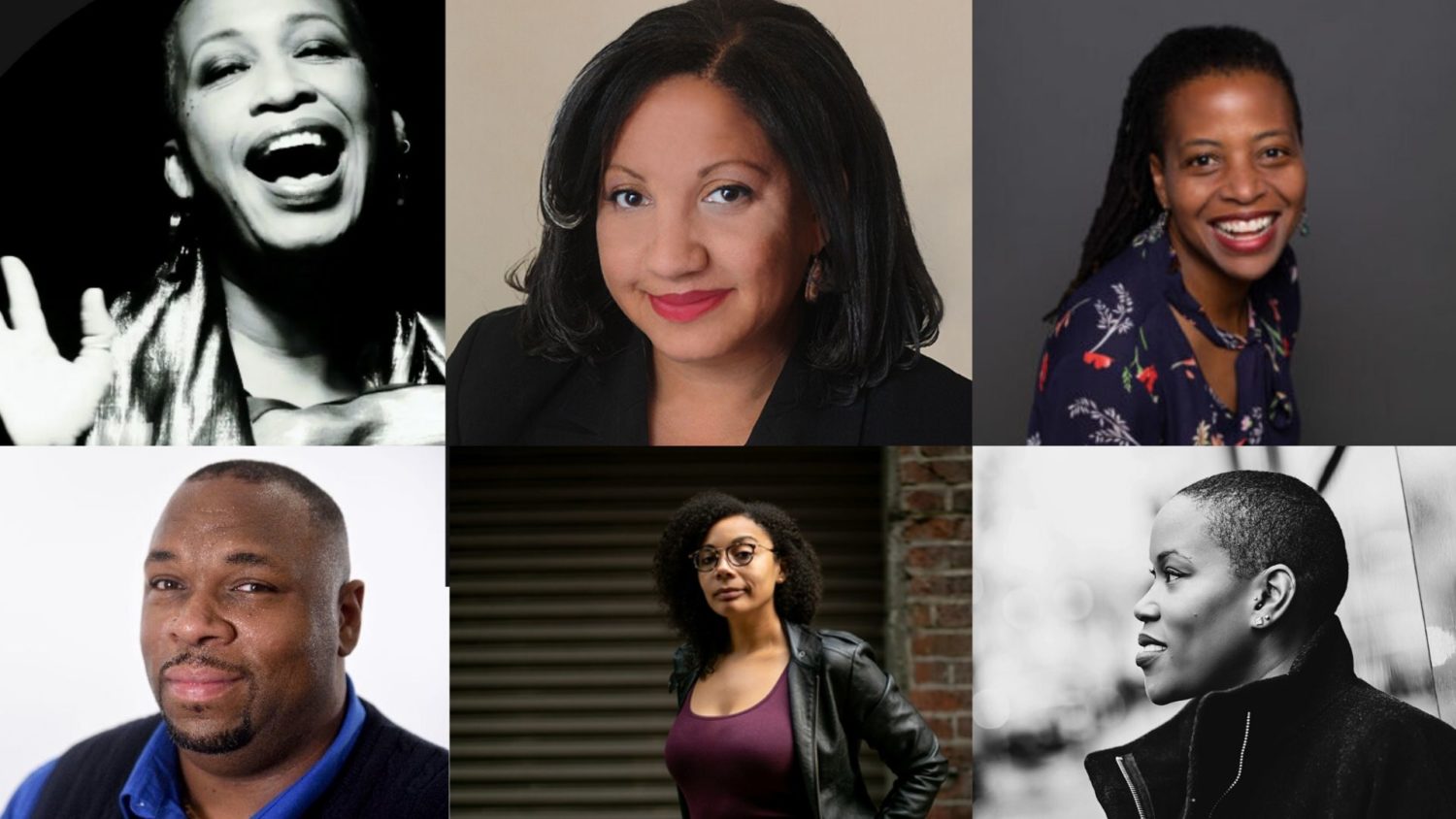Lori Tharps was at work in her basement home office in Philadelphia on June 19 when she got a text: The Associated Press Stylebook — the grammar bible for journalists — would start capitalizing the B in Black when referring to people and culture.
She screamed.
Sarah Glover was driving to cover a Juneteenth event at Malcolm X Park in Philly. At a stoplight, notifications on her phone lit up with the news. She pulled over to the side of the road and started texting and calling colleagues to celebrate.
Marlon A. Walker was driving in Atlanta when a notification with the news popped up on the screen of his car. He hurried home to read more.
Meredith Clark was scrolling Twitter for something else from her home in Charlottesville when she saw the news fly by.
“BLESSED,” she tweeted with the AP’s news.
And Bobbi Booker was on a short break from hosting her jazz radio show at Philly’s WRTI when the news came across her screen. She pushed her chair back and jumped up silently, clapping, before sitting back down, hand over heart, still bouncing with excitement.
Those journalists all greeted the stylebook change news with joy, celebration, and the frustration that it took way too damn long. They’re among the people who worked privately and in public for years to push mainstream American newsrooms to acknowledge Blackness as a culture and identity worthy of a proper noun.
In 2003, Aly Colón wrote for Poynter about why it made sense to capitalize the B — and he predicted it might not happen for a good long while.
“… Many publications use AP style and AP determines its style by watching what other publications do. I see the possibility of circular thinking that may make change difficult. If we only listen to each other, how will we hear voices different from our own?”
So if the AP was waiting for newsrooms to change and most mainstream newsrooms were waiting for the AP, that meant a small group of people had to do a great deal of work.
Standards
Bobbi Booker started writing when she was 8 and became a journalist at 15. She always capitalized the B in Black.
“This has always been my standard.”
Early in her career, that one letter led to a lot of struggles with editors.
In the ’90s and early 2000s, she covered music and got publications including the City Paper and Philadelphia Weekly to allow it, in part because it was also the preference of the Black artists she covered. Philadelphia Magazine agreed, reluctantly, she said, and she made the appeal individually to Black journalists hired by the magazine over the years.
In 1999, Booker appealed to the Philadelphia Association of Black Journalists to push for the adoption of Black by the chapter and was “summarily dismissed.” She continued making the appeal regularly. Sarah Glover was in the room for one of those meetings. The consensus was quick, Glover remembers. The chapter would continue to follow AP style.
Booker, who is also the first Black president of Philly’s Pen and Pencil Club, America’s oldest press club, kept capitalizing that B and demanding it in her own work.
“I wouldn’t write for anyone if they did not agree to my one demand,” she said. “And that one demand was the capitalization of Black … Listen, your editorial standard is your editorial standard, but mine is mine. And it’s not just about me.”
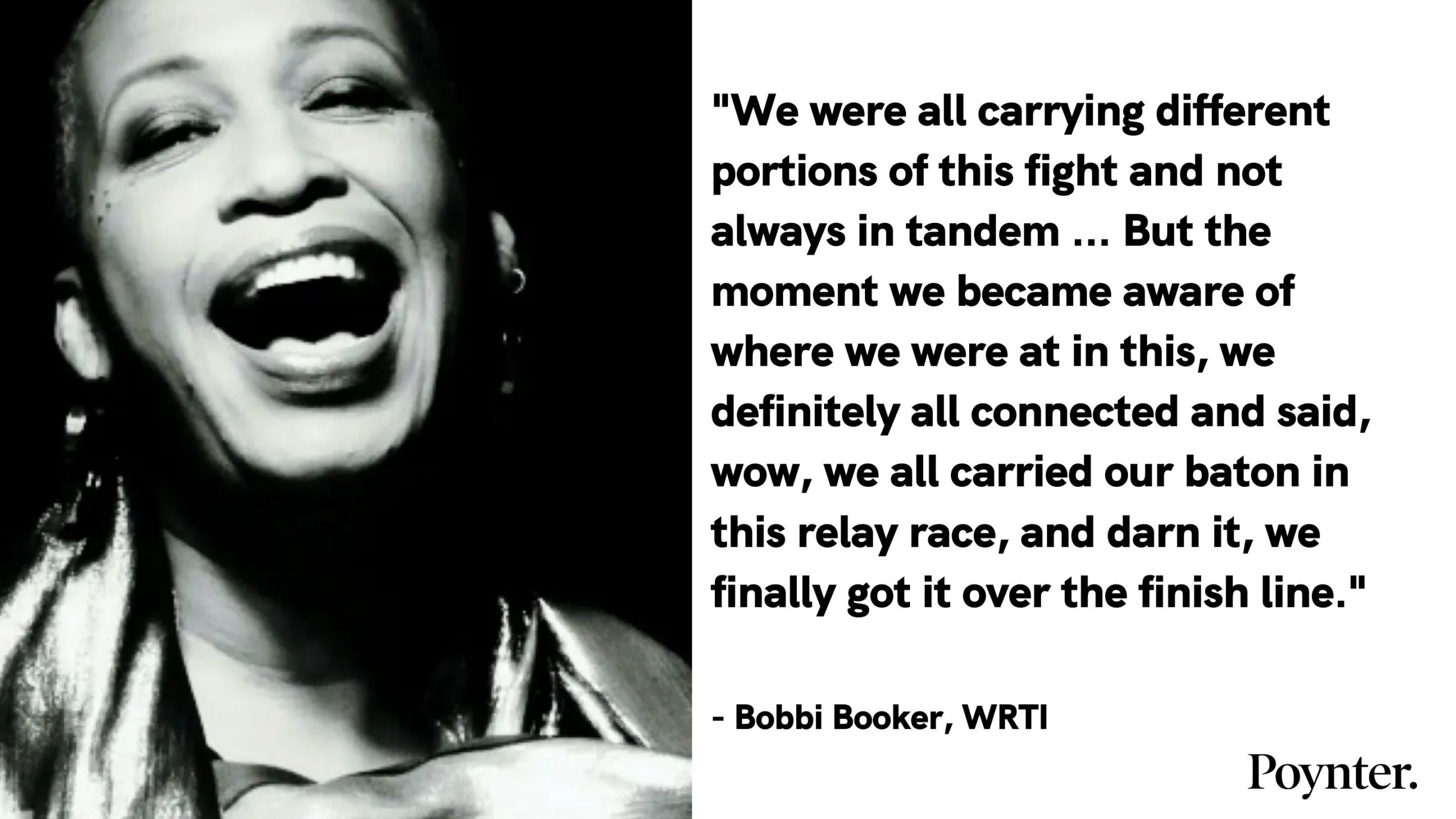
Image courtesy Bobbi Booker
The diminutive form
In 2003, Aly Colón, then teaching ethics and diversity, spoke with Poynter’s editor at the time, the Associated Press and the head of ACES: The Society for Editing about capital B Black.
He wrote:
“To me, it’s an issue of respect, fairness, equality, and parity. When we use a lowercase letter it makes the word less visible, less prominent, and maybe less important. It’s the diminutive form. My name is written with an uppercase ‘A’ and ‘C’ for “Aly Colón.” I consider that a sign of respect.”
A year later, Colón wrote about the use of accent marks, urging newsrooms to use them in order to spell the names of people and places correctly. There, he found another topic where an easy change was, in fact, not.
The impression Colón got from reporting both pieces was that the arbiters of style felt they knew best and saw no need for change at the time.
A letter of record
From her office at Temple University, Lori Tharps overheard a conversation in 2014 that felt familiar.
Another professor was berating a student for capitalizing Black.
Tharps could hear the resignation in that student’s voice as she tried to defend herself and was, instead, made to feel silly.
“Just hearing it out loud made me so mad.”
That lowercase b made Tharps, a journalist and associate professor at Temple’s Klein College of Media and Communication, feel the same way that she felt as the only Black girl in her Milwaukee neighborhood — small, inferior, not worthy of acknowledgment.
And as a professional writer, every time she had to use lowercase black alongside Asian Americans or Latinos, it made her feel like a second-class citizen.
Tharps started to build a case for mainstream adoption of the change, and when she looked back in history, found she wasn’t the only one. In the 1920s, W.E.B. Du Bois started a letter-writing campaign to get the n capitalized in Negro.
“This great man, this great Black intellectual had fought the exact same fight for the exact same reason.”
She found that in 1929, an Encyclopedia Britannica editor told Du Bois that Negro would be lowercased. Du Bois responded, calling “… the use of a small letter for the name of twelve million Americans and two hundred million human beings a personal insult.”
Tharps made the case for Black in The New York Times in 2014.
She ended with this:
“If we’ve traded Negro for Black, why was that first letter demoted back to lowercase, when the argument had already been won? Publications like Essence and Ebony push back, proudly capitalizing the B. But claiming the uppercase as a choice, rather than the rule, feels inadequate. Black should always be written with a capital B. We are indeed a people, a race, a tribe. It’s only correct.”
Then, she started a petition online, urging the AP and The New York Times to make the change.
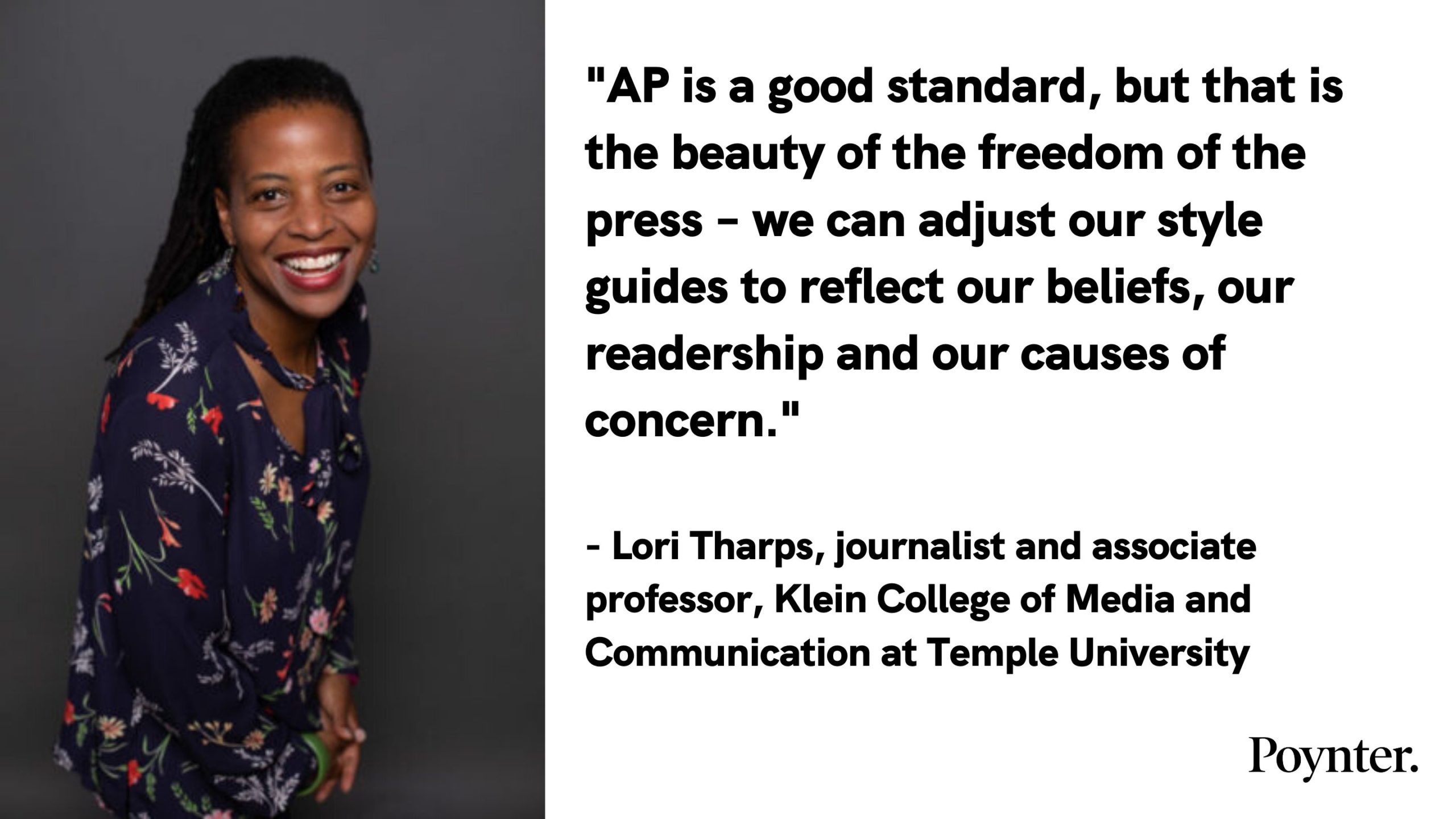
Image courtesy Lori Tharps
In 2015, Meredith Clark made the call in a column for Poynter (which I edited.) Clark, an assistant professor at the University of Virginia, shared Tharps’ work and wrote:
It’s a basic matter of extending human dignity to the people who define themselves by the legacy of the African descendants’ American experience. It is fundamentally the same gesture of dignity that same-sex couples and immigration advocates have won in years past. Those victories are a reminder that thoughtful consideration of identity politics matter to all of us, especially in the language we use to define ourselves and each other.
Still, nothing changed.
And I want to be clear here, nothing changed at Poynter then, either. We made the case, through Clark’s column. I emailed her that we were making the change internally. The editorial team did. It stuck for a while. But we never made it part of our internal stylebook. After meeting with a bit of resistance, I personally stopped making the case.
Like a lot of places, we had an opportunity five years ago. We wasted it.
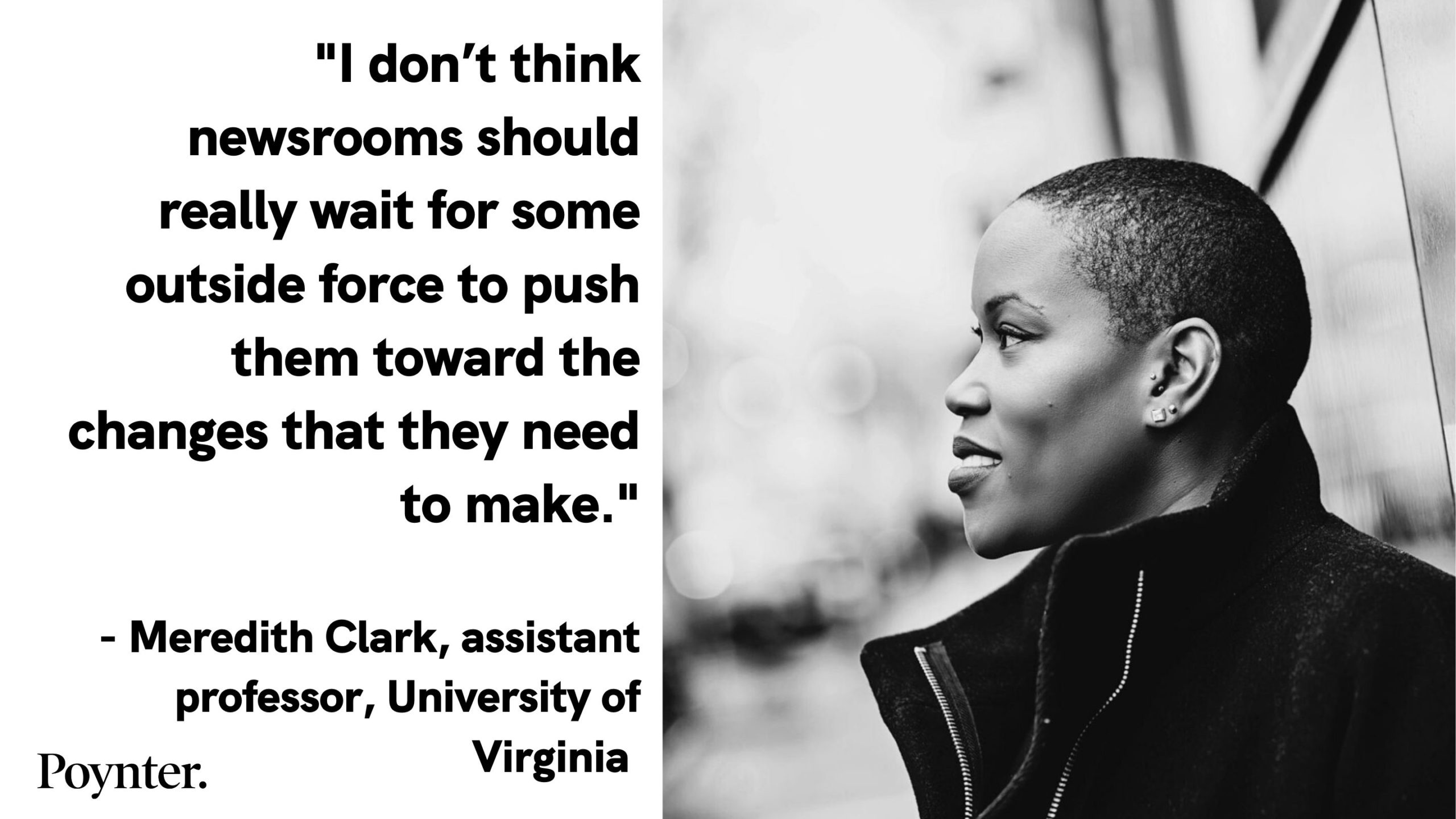
Image courtesy Meredith Clark
That’s the problem
When Sarah Glover became president of the National Association of Black Journalists, her main concern on language was another matter — the use of “boy” when talking about Black men.
During the protests in Baltimore that followed Freddie Gray’s death in 2015, she remembers an AP headline about a mother who punished her son for participating.
She remembers an early headline, however, that read something like “woman beats boy.”
Except the “boy” was taller than the woman and clearly a young man (turns out he was 16.)
“That really bothered me,” said Glover, manager of social media strategy of NBC Owned Television Stations.
Glover saw, again and again, stories where editors and reporters weren’t considering cultural nuances, context or history. But when she’d object, journalists would default to the bible of style: the AP Stylebook.
“It just dawned on me in that moment,” Glover said. “That’s the problem.”
In January of 2018, she reached out to the AP in an email (and used what was then AP style when writing Black.)
“Please consider adding that the use of ‘boy’ when describing a black or African American male may be perceived as offensive. Seek to avoid that reference for a black child and opt for the terms: child, teen or young person. Historically, Boy has derogatory meaning when referring to black males. The term has been used to demean and talk down to black males in the 20th Century. During the Civil Rights Movement, black men carried signs, ‘I Am a Man,’ to call attention to issues of second class citizenship. The signs were used in protests in Memphis, the March on Washington and at numerous Civil Rights events.”
Glover didn’t expect the AP to be responsive, she said, but it was. She started working with Jeff McMillan on the Stylebook team.
In 2018, the Stylebook was updated to include this under race-related coverage:
boy, girl Generally acceptable to describe males or females younger than 18. While it is always inaccurate to call people under 18 men or women and people 18 and older boys or girls, be aware of nuances and unintentional implications. Referring to Black males of any age and in any context as boys, for instance, can be perceived as demeaning and call to mind historical language used by some to address Black men. Be specific about ages if possible, or refer to Black youths, child, teen or similar.
NABJ’s vice president of print, Marlon A. Walker, worked with Glover to talk through other style changes with the AP, including the elimination of colors (like Blacks and whites) as singular nouns. In 2019, they returned to the AP to press for capitalizing the B in Black. NABJ itself to made the change with its own communications.
Before then, the decision to stick with the stylebook had always prevailed. After, NABJ used capital B Black in official communications.
In June of 2020, NABJ made an official announcement about the change.
“For the last year, the National Association of Black Journalists (NABJ) has been integrating the capitalization of the word “Black” into its communications.
However, it is equally important that the word is capitalized in news coverage and reporting about Black people, Black communities, Black culture, Black institutions, etc.
NABJ’s Board of Directors has adopted this approach, as well as many of our members, and recommends that it be used across the industry.”
On June 11 of this year, Glover wrote an open letter to the AP and newsrooms and sent it to several organizations, including Poynter, CJR and New York Amsterdam News, a Black publication in New York. The Amsterdam News published her piece within the hour.
“In the wake of the George Floyd tragedy and the subsequent call to eradicate racism that’s manifested via protests worldwide, I’m writing today to request the mainstream news media begin capitalizing the ‘B’ in Black when describing people and the community.
“I’m also asking the Associated Press (AP) to update its Stylebook to reflect this change, effective immediately. This book is the bible for working journalists and sets journalistic industry standards. The AP has tremendous impact as a wire service with more than 1,000 subscribers worldwide.
“Black is an encompassing term that is readily used to refer to African Americans, people of Caribbean descent and people of African origin worldwide. Capitalizing the ‘B’ in Black should become standard use to describe people, culture, art and communities. We already capitalize Asian, Hispanic, African American and Native American.”
Eight days later, on the afternoon of June 19, the AP announced the change.
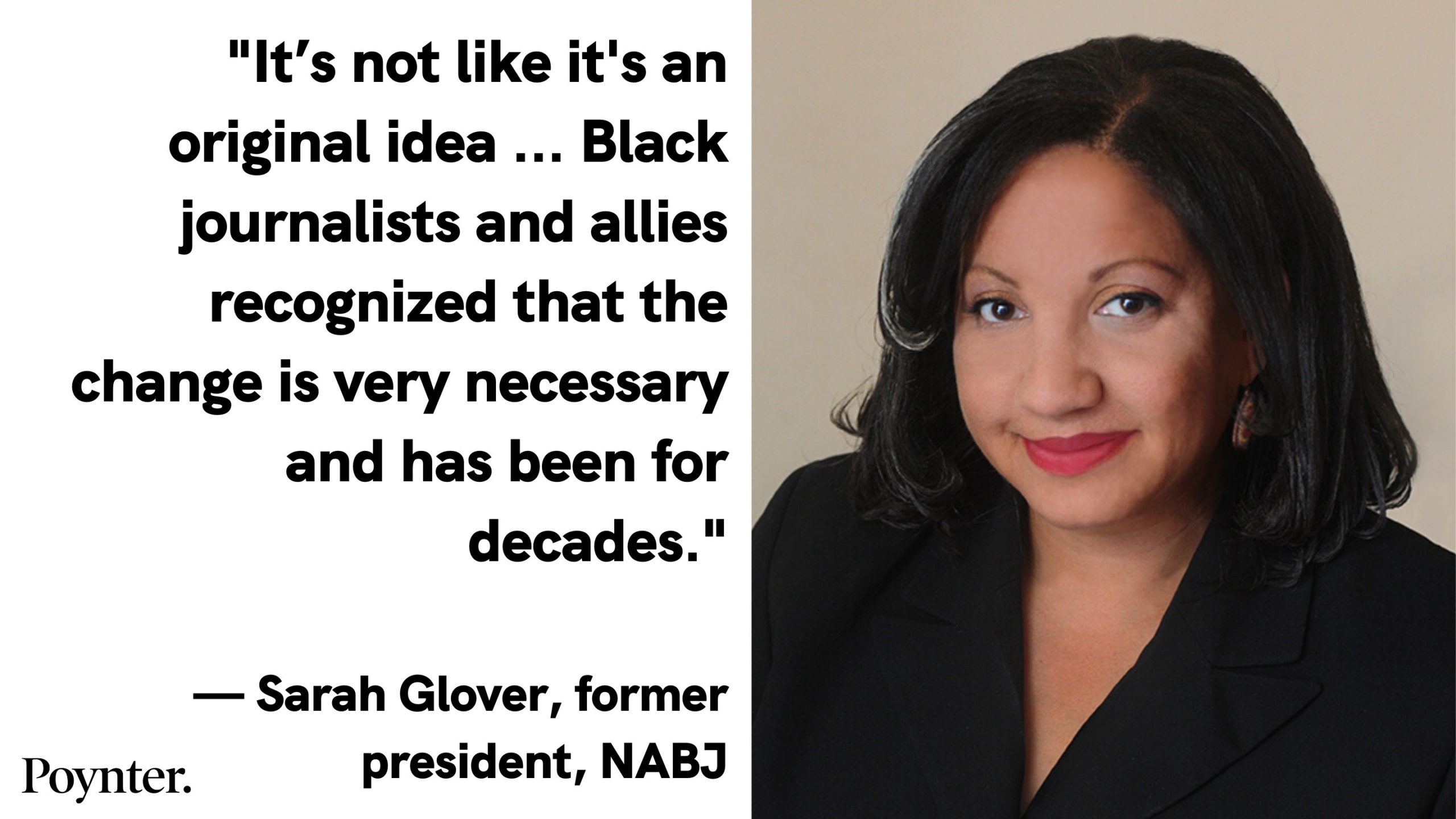
Image courtesy Sarah Glover
Inside the AP
The Associated Press responded to questions about this process via email. According to vice president and editor-at-large for standards John Daniszewski, here’s what happened:
The AP Stylebook team had discussed the capitalization of Black — along with the question of white or White — a number of times over the past few years. The Stylebook team also consulted with the AP’s Race and Ethnicity beat team over that time — the team of reporters and editors who cover issues related to race and racial injustice — and it read many arguments in publications and social media.
Requests that we capitalize Black were compelling, but relatively few in number. We heard from some people who felt that black should not be capitalized. And the question of white or White was a necessary consideration; we felt one couldn’t be decided without similar in-depth consideration of the other.
Stylebook team member Jeff McMillan talked and emailed a number of times with Sarah Glover and others in NABJ on behalf of AP’s Stylebook team, and he heard mixed opinions.
Those discussions, as well as a conversation among a diverse group of AP staff, helped shape the big race-related coverage Stylebook entry of last year. Among its many points, the entry gives guidance on the terms “racist” and “racially charged.”
The team joined by Deputy Managing Editor Amanda Barrett and myself renewed the discussion in January following a request from NABJ. Following George Floyd’s killing in May, the discussion intensified and expanded to include AP’s top news leaders.
The senior news leadership, in a 90-minute conference call with AP Race and Ethnicity team leader Andale Gross and Stylebook Editor Paula Froke, decided on June 19 to change AP style to Black and Indigenous. The group concluded that more discussion and reporting was needed to resolve the question of white or White. We set a deadline for that decision within a month.
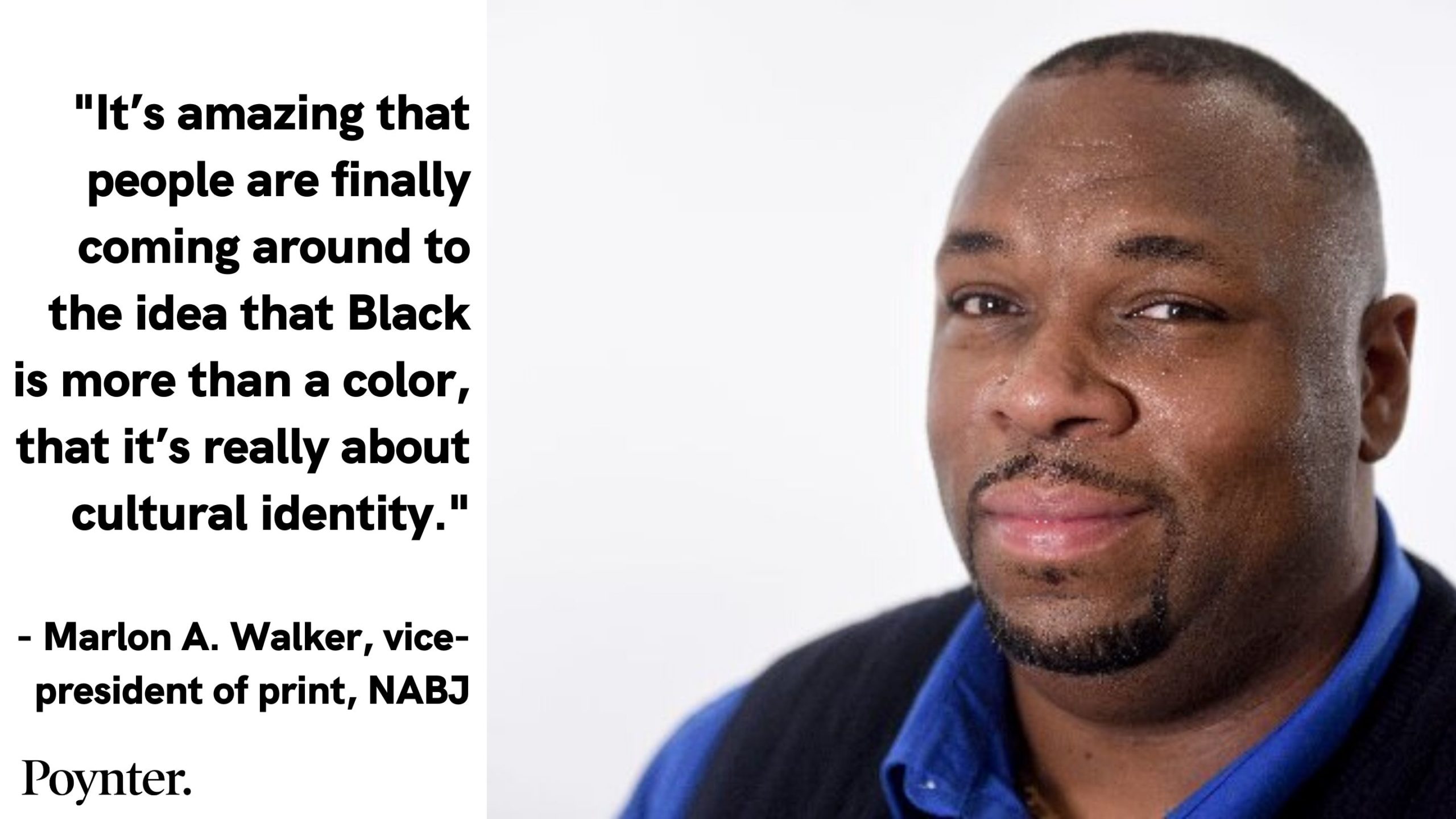
Image courtesy Marlon A. Walker
The newsrooms that didn’t wait
Fifteen years ago, when Nayaba Arinde started working at New York Amsterdam News, a weekly Black paper, she insisted on capital B Black.
“I thought it was an important move,” Arinde said, “whether the Associated Press did it or not.”
Brookings Institution, a non-profit public policy organization, made the change in September of 2019. The Daily Orange, a student-run publication at Syracuse University, announced it would capitalize Black starting this January.
And while many newsrooms made the change before the AP in the past month — including NBC and NBC Owned Television Stations, where Glover worked to make the change internally, The Atlanta Journal-Constitution, where Walker works and Philadelphia Magazine, where Booker is an occasional columnist — a few came to their own decision before this June because they listened to people in their newsrooms and their communities.
Here are two quick examples:
Crystal Paul, a features reporter at The Seattle Times, has always capitalized the B in Black, she said, “in a sort of independent protest.”
Paul is one of five Black journalists in the newsroom, which has about 150. She knew if an editor didn’t catch it, a copy editor would.
But when Laura Gordon edited one of Paul’s stories early last year, Gordon noticed that B and asked Paul about it. The two talked about it at the time.
The conversation restarted again after Paul sent Gordon, a news project manager, an October 2019 story by George M. Johnson that ran in Mic. Paul and Gordon worked with colleagues Naomi Ishisaka and Vianna Davila, then the Times’ diversity and inclusion task force, to make the case to copy desk chiefs and senior newsroom leaders.
On December 19, the Times announced the change.
“It is increasingly clear this is the preferred term among many Black publications and presses. It seems appropriate and respectful for us to follow suit,” said Ray Rivera, the Times’ managing editor, who oversees standards for the news organization.
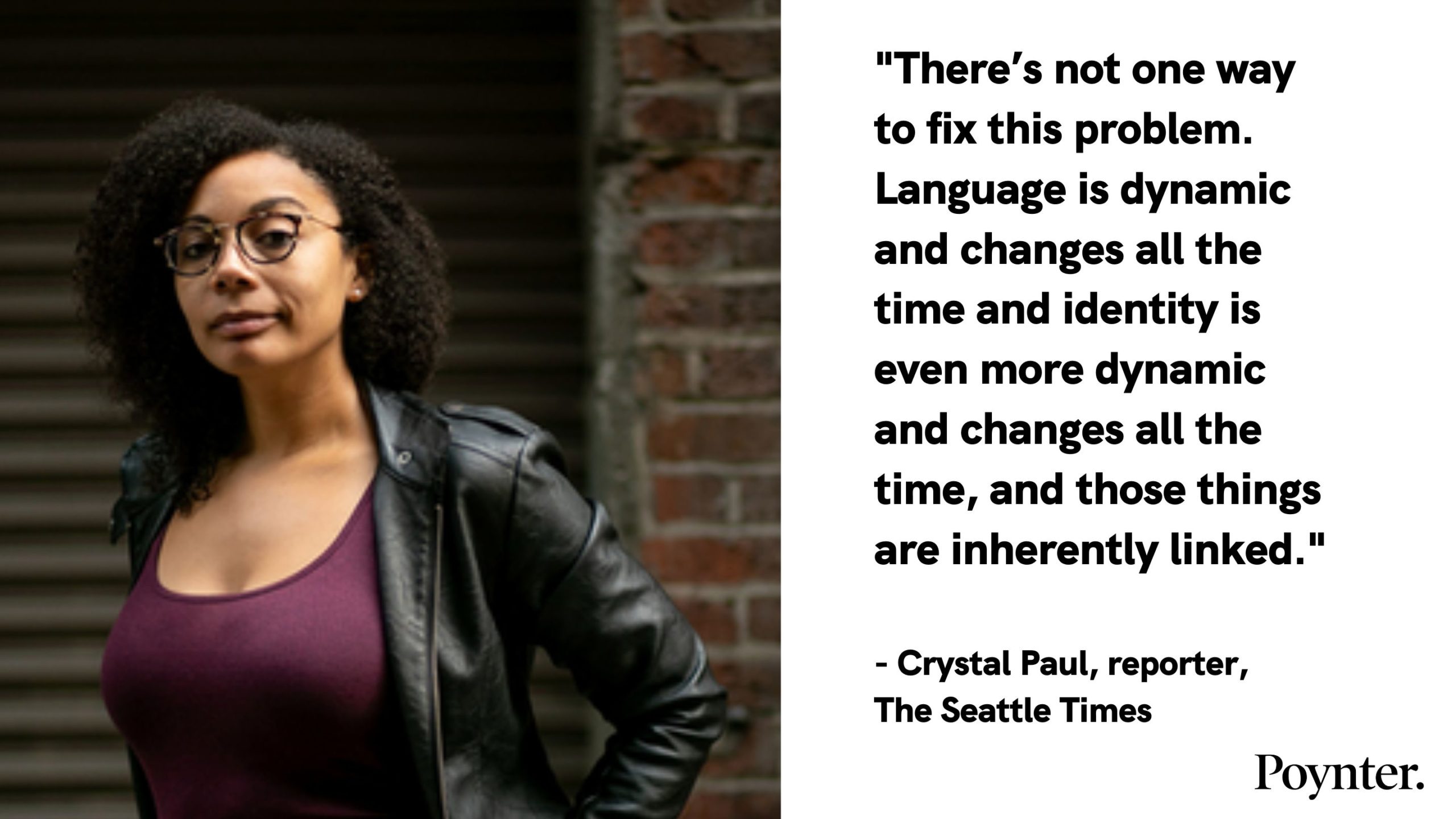
Photo by Erika Schultz/The Seattle Times
As the Boston branch of the NAACP prepared to host this summer’s national convention, it started reaching out to local media about a number of stories.
Brian McGrory, The Boston Globe’s editor, remembers the group had a few requests. One of them was about capital B Black.
“If the Globe were to adopt this change, it was our hope that other media in this area would do the same,” said Tanisha M. Sullivan, Esq., the Boston branch’s president.
She told McGrory that every time she reads the newspaper and sees “black” next to Latinx, Asian, Hispanic and other races, “that for me is like a dagger every time I read it. For me it says, who am I? Do I exist?”
McGrory took the change to the newsroom, where the response was positive. In January, McGrory announced the change internally.
It’s the first time he can remember making a stylebook change at the Globe.
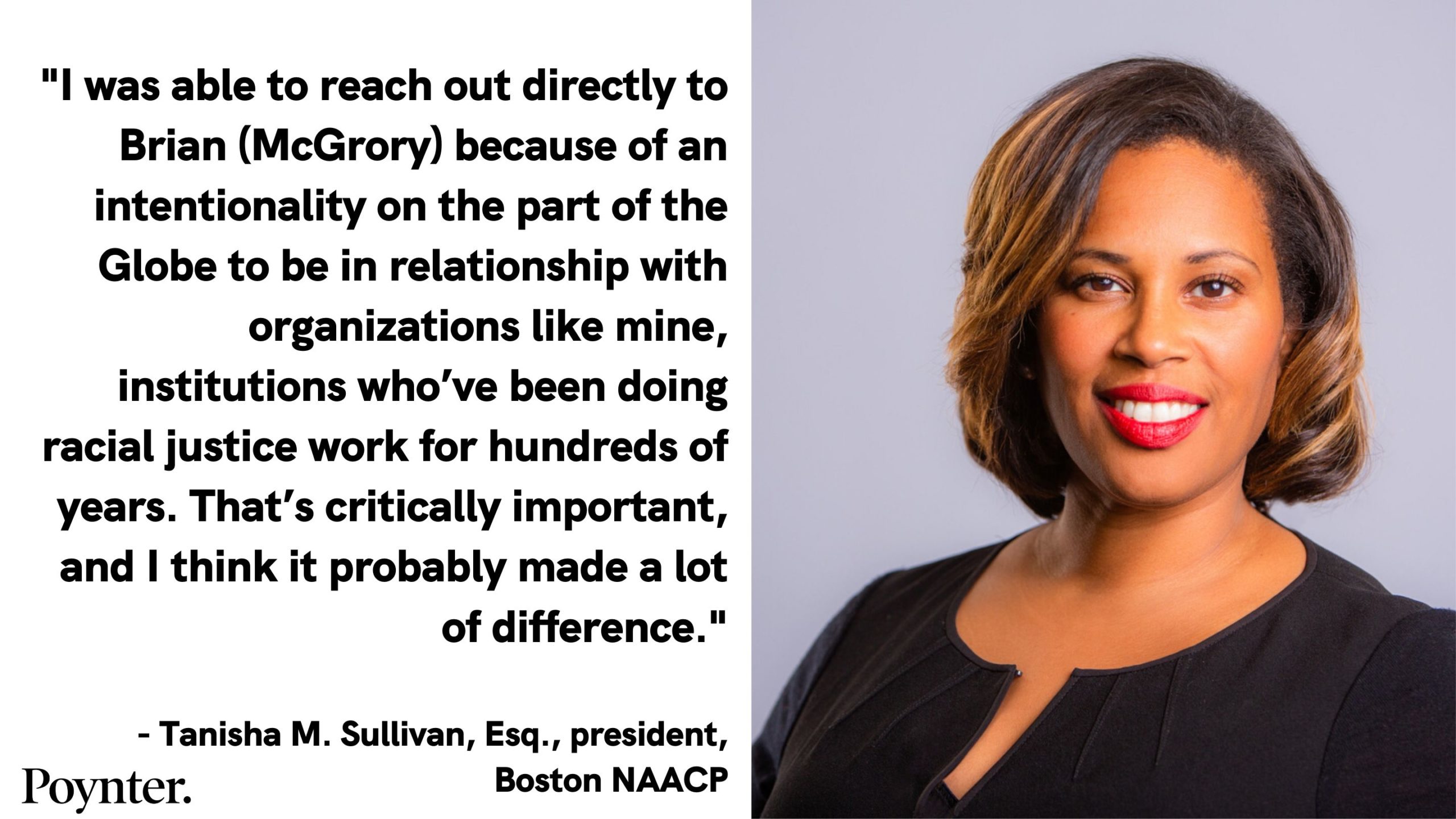
Image courtesy Tanisha Sullivan
What about w for white?
What about capitalizing the W in “white” people?
The two often get tangled in internal discussions, including with the AP and at Poynter.
In June, the NABJ recommended “whenever a color is used to appropriately describe race then it should be capitalized, including White and Brown.”
Columbia Journalism Review uses Black and white because “For many people, Black reflects a shared sense of identity and community. White carries a different set of meanings; capitalizing the word in this context risks following the lead of white supremacists.”
The AP promises a decision soon.
But for Tharps, they’re two separate issues.
“To capitalize the B in Black has nothing to do with white Americans, and to conflate the two issues would be a grave mistake,” she said.
Black Americans have their own culture because of slavery, she said, because their cultures were ripped from them and denied. White people know where their ancestors came from.
The correct response to this question, Tharps said, is “it’s not about you … I don’t think white people care and they shouldn’t because they’ve never been forced to have their identity stripped from them.”
Shift
It’s just one letter.
Getting it capitalized by the institution that sets style and grammar for mainstream American news organizations might seem like a small thing, Glover said, “but it’s a big thing. It’s a big deal, and it’s the first big step that should result in other steps being taken to make sure that news coverage is inclusive.”
That one letter allows communities to define themselves. It’s pride. Affirmation, she said.
And “it’s literally low-hanging fruit.”
Tharps, who wrote about the change in The New York Times, sees a victory.
“I’ve been saying this is my march on Washington,” she said. “This is seriously something that I have officially been asking for since that article in 2014.”
Poynter, for what it’s worth, officially made the change on June 4.
But why did it all take so long?
“When we see ourselves as the arbiters of what is right, we think we are right,” said Colón, who wrote about the issue 17 years ago and is now the John S. and James L. Knight Professor of Media Ethics at Washington and Lee University in Lexington, Virginia. “It really is so different from what I believe journalism is about, which is not only reaching out to people, but listening to them and respecting who they are and their point of view.”
Tharps doesn’t think publications or journalists were trying to be deliberately racist, “but I don’t think that they were being competent in not interrogating this style rule more thoroughly after my article came out.”
There is a lot the stylebook change doesn’t do, too, including actually diversifying newsrooms to look like the communities they serve. That work, and much more, remains.
It is, though, a psychological improvement, Tharps said. Walker agreed. It suggests newsrooms are at least open to discussing even more complicated things.
And if you’re wondering about the term African American, Tharps doesn’t think it is necessarily problematic, “it’s just that it doesn’t feel 100% accurate to claim African American when our connection to Africa is so distant compared to, say, an Asian American.”
If people prefer that term, she said, that’s fine.
Tharps’ focus now is relishing the significance of the latest change itself. She works in words. In the days since the announcement, she’s gleefully hit shift + b knowing she wouldn’t have to fight copy editors anymore.
At least, she won’t have to fight most of them.
In emailed statements last week, both The Washington Post and The New York Times, where Tharps started her own campaign, told Poynter they were still considering the change. On June 30, shortly before this story published, the Times announced it would capitalize the B in Black.
Kristen Hare covers the business and people of local news for Poynter.org and is the editor of Locally. You can subscribe to her weekly newsletter here. Kristen can be reached at khare@poynter.org or on Twitter at @kristenhare.

